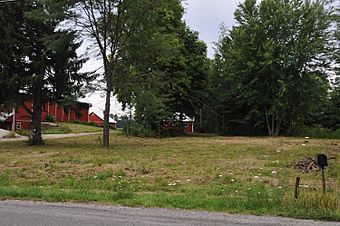Paleo Crossing Site facts for kids
Quick facts for kids |
|
|
Paleo Crossing Site
|
|
 |
|
| Location | Northwest of the junction of Ridgewood and State Roads, Sharon Township, Medina County, Ohio (private) |
|---|---|
| Nearest city | Sharon Center, Ohio |
| NRHP reference No. | 92000972 |
| Added to NRHP | July 30, 1992 |
Paleo Crossing Site, also known as the Old Dague Farm Site, is an archaeological site near Sharon Center, Ohio in Medina County where Clovis artifacts dated to 13,000 years ago were found. The Cleveland Museum of Natural History conducted an excavation from 1990 to 1993. The site provides evidence of Paleo-Indians in northern Ohio and may be the area's oldest residents and archaeologist Dr. David Brose believes that they may be "some of the oldest certain examples of human activity in the New World." The site contains charcoal recovered from refuse pits. There were also two post holes and tools that were made from flint from the Ohio River Valley in Indiana, 500 miles from Paleo Crossing, which indicates that the hunter-gatherers had a widespread social network and traveled across distances relatively quickly. The post holes are evidence that there was a shelter built on the site.
The site was listed on the National Register of Historic Places on July 30, 1992.
Excavation
Spearheads were found by a local artifact collector in Sharon Center, Ohio. From 1990 to 1993, the site was excavated by the Cleveland Museum of Natural History. Dr. David Brose, the former Curator of Archaeology, found the spearheads where in the style of Clovis points of the Paleo-Indians and "some of the oldest certain examples of human activity in the New World." The Clovis culture spread across North America and the people are thought to be the ancestors of most native peoples in America. There are about 200 Clovis sites on the continent, but most did not provide a lot of information about the Clovis lifestyle.
The Paleo Crossing site, one of the oldest sites in Ohio, had two or three post holes and refuse pits that contained charcoal. From carbon dating, the site was used about 13,000 years ago or 13,120 B.C. The post holes and an area about 150 square feet indicate that there was a structure at the site. If so, it would be the oldest structure ever found in North America. The structure, carbon-dated at about 10,200 B.C., could have burned, based on the presence of charcoal found in a post hole.
More than 10,000 artifacts were found at the site. Most of the flint tools were made from stone unique to a quarry about 500 kilometres (310 mi) away in southern Indiana.
Terrain
When Paleo-Indians visited the site, glacial ice had probably receded and it is likely that it was a "lush" environment with vegetation. A bog was nearby, which would have lured animals, like mastodons to the water. The structure was placed above what was once a bog and below a ridge. The bog is now wet farmland.
Current land use
The Paleo Crossing site is in a residential area.
- Metin I. Eren & Brain G. Redmond (2011) "Clovis Blades at Paleo Crossing (33ME274)", Ohio, Midcontinental Journal of Archaeology, 36:2, 173-194, DOI: 10.1179/mca.2011.009



